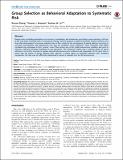| dc.contributor.author | Zhang, Ruixun | |
| dc.contributor.author | Brennan, Thomas J. | |
| dc.contributor.author | Lo, Andrew W. | |
| dc.date.accessioned | 2014-12-23T20:52:29Z | |
| dc.date.available | 2014-12-23T20:52:29Z | |
| dc.date.issued | 2014-10 | |
| dc.date.submitted | 2014-07 | |
| dc.identifier.issn | 1932-6203 | |
| dc.identifier.uri | http://hdl.handle.net/1721.1/92488 | |
| dc.description.abstract | Despite many compelling applications in economics, sociobiology, and evolutionary psychology, group selection is still one of the most hotly contested ideas in evolutionary biology. Here we propose a simple evolutionary model of behavior and show that what appears to be group selection may, in fact, simply be the consequence of natural selection occurring in stochastic environments with reproductive risks that are correlated across individuals. Those individuals with highly correlated risks will appear to form “groups”, even if their actions are, in fact, totally autonomous, mindless, and, prior to selection, uniformly randomly distributed in the population. This framework implies that a separate theory of group selection is not strictly necessary to explain observed phenomena such as altruism and cooperation. At the same time, it shows that the notion of group selection does captures a unique aspect of evolution—selection with correlated reproductive risk–that may be sufficiently widespread to warrant a separate term for the phenomenon. | en_US |
| dc.description.sponsorship | MIT Laboratory for Financial Engineering | en_US |
| dc.language.iso | en_US | |
| dc.publisher | Public Library of Science | en_US |
| dc.relation.isversionof | http://dx.doi.org/10.1371/journal.pone.0110848 | en_US |
| dc.rights | Creative Commons Attribution | en_US |
| dc.rights.uri | http://creativecommons.org/licenses/by/4.0/ | en_US |
| dc.source | Public Library of Science | en_US |
| dc.title | Group Selection as Behavioral Adaptation to Systematic Risk | en_US |
| dc.type | Article | en_US |
| dc.identifier.citation | Zhang, Ruixun, Thomas J. Brennan, and Andrew W. Lo. “Group Selection as Behavioral Adaptation to Systematic Risk.” Edited by Claude Wicker-Thomas. PLoS ONE 9, no. 10 (October 29, 2014): e110848. | en_US |
| dc.contributor.department | Massachusetts Institute of Technology. Computer Science and Artificial Intelligence Laboratory | en_US |
| dc.contributor.department | Massachusetts Institute of Technology. Department of Electrical Engineering and Computer Science | en_US |
| dc.contributor.department | Massachusetts Institute of Technology. Department of Mathematics | en_US |
| dc.contributor.department | Sloan School of Management | en_US |
| dc.contributor.mitauthor | Zhang, Ruixun | en_US |
| dc.contributor.mitauthor | Lo, Andrew W. | en_US |
| dc.relation.journal | PLoS ONE | en_US |
| dc.eprint.version | Final published version | en_US |
| dc.type.uri | http://purl.org/eprint/type/JournalArticle | en_US |
| eprint.status | http://purl.org/eprint/status/PeerReviewed | en_US |
| dspace.orderedauthors | Zhang, Ruixun; Brennan, Thomas J.; Lo, Andrew W. | en_US |
| dc.identifier.orcid | https://orcid.org/0000-0002-6908-4236 | |
| dc.identifier.orcid | https://orcid.org/0000-0003-2944-7773 | |
| mit.license | PUBLISHER_CC | en_US |
| mit.metadata.status | Complete | |
